Mayevsky crane: device, principle of operation and overview of typical installation diagrams
Water heating lines have a characteristic feature. When pipelines are filled with water, part of the system remains occupied by air cushions.Normal operation of water heating in such cases is not ensured, so air from the pipelines must be removed manually.
The Mayevsky tap helps to get rid of air jams - the simplest mechanism for manually bleeding air. In the article we presented, the principle of operation of the device is analyzed in detail and alternative options are considered. The recommendations we provide will be useful in installation and operation.
The content of the article:
Design and principle of operation of the device
Mayevsky’s cranes, familiar to many, were made to be controlled with a special key or a mechanic’s screwdriver. That is, in fact, such products cannot be called automatic devices.
Modern prototypes of Mayevsky cranes - automatic air vents - have been somewhat improved by designers.
Automatic models work without any third-party intervention.
But in plumbing practice there are various design variations of Mayevsky taps:
- straight rod manual;
- angular rod manual;
- float vertical automatic.
Manual and automatic options are somewhat different in that the former can be mounted in almost any position, while the latter can only be mounted in a vertical position.
Manual structures are traditionally mounted directly into the body of radiator panels or batteries.Automatic air vents, as a rule, are designed for installation on lines in points of the heating system that are difficult to access for maintenance.
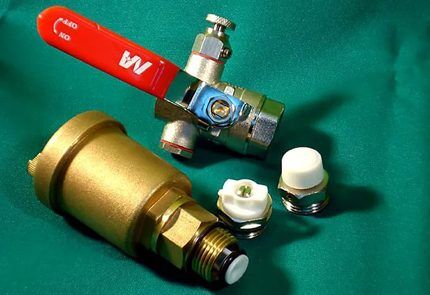
The operating principle of the Mayevsky crane is based on the interaction of the simplest parts. Manual designs actually represent a conventional needle valve.
The elements of such a valve are:
- The case is metal.
- Rod with thread and through grooves.
- A cap with a channel for air outlet.
- Rubber ring seal.
Brass is traditionally chosen as the material for the manufacture of Mayevsky taps. True, a separate part of the mechanism - a cap with an air channel - can be made of nylon, nylon, or high-temperature plastic.
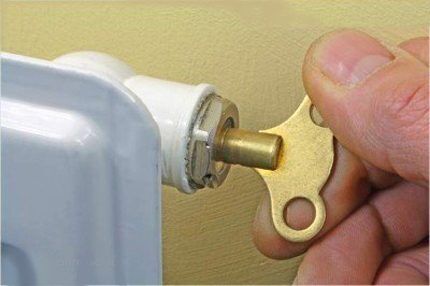
The brass body of the device has a thread along the outer diameter of the lower part. This part of the body is screwed into the seat of the heating radiator plug.
Operation of the hand tap mechanism
It's simple. In the normal state, the control rod screw is screwed until it stops with the needle part into the annular shell of the drain hole.
When it becomes necessary to free the system from an air lock in the radiator, the plumber (or homeowner) uses a wrench or a screwdriver to unscrew the screw 2-3 turns. Due to the large difference in density between water and air, the latter flows first through the opened outlet hole.
Then the air flow rushes through the longitudinal grooves of the rod and enters the area under the nylon cap. From there, the air mass is ejected through the outlet channel. As soon as the air flow has stopped and water follows, the plumber tightens the screw of the Mayevsky tap until it stops. This completes the air release procedure.

Periodically the procedure removal of air from contour heating is repeated, since it is not possible to bleed the entire volume of air at one time.
Operating principle of automatic air vents
The action of the machine gun, a follower of the Mayevsky crane, seems somewhat different. The operating principle of a similar product, but operating automatically, differs significantly from the manual standard. The automatic air outlet valve is located in a cylindrical body. A float mechanism is installed inside the cylinder.
The float of the mechanism is connected by a system of levers to a needle rod. In this design, the rod has a vertical position. Its needle-shaped end acts as a valve that blocks or unblocks the hole in the upper part of the cylinder. The air-water medium inlet is provided in the lower part.
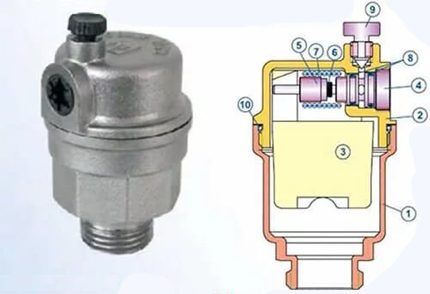
Due to the presence of water inside the air vent cylinder, the float is raised by pressure. The pressure force presses the needle part of the valve. That, in turn, closes the upper outlet.
But as soon as air gets inside the cylinder, the force of water pressure on the float weakens, and the needle part of the valve moves down. The upper calibration hole opens, through which air is thrown out. As the air bubble disappears, the cylinder is filled with water again. The valve is set by a float to the “closed” position.
How is the air exhaust mechanism installed?
The Mayevsky manual tap is a self-sealing device. The product kit includes an O-ring made of rubber, so there is no need to use any additional sealing materials.
Traditionally, the installation of manual valves for bleeding air of this type is performed in conjunction with radiator fittings (1 dm x ½ dm; 1 dm x ¾ dm). As an installation tool, use a spanner wrench specially designed for working with fittings and plugs.
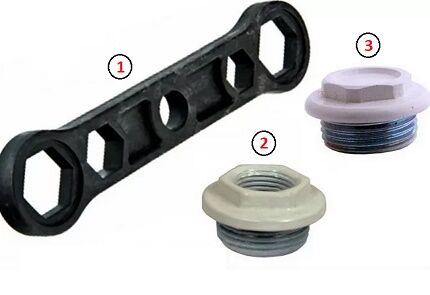
The operation of Mayevsky valves (air vents) is permissible only at the pressure and temperature values specified in the standards. These values are determined by the technical characteristics of the device.
Technical characteristics of the air vent
The required functional properties are presented in the following table:
| Technical specifications | Permissible value | Units |
| Pressure (working) | 10 | ATI |
| Temperature (maximum) | 120 | ºС |
| Passage diameter | 25.4 or 20.0 | mm |
| Thread diameter | 25.4 or 20.0 | mm |
| Working environment | water and other non-aggressive liquids | — |
| Life time | 20 — 25 | years |
| Leakage class | "A" | — |
During operation, malfunctions in the operation of the devices cannot be ruled out. A frequent reason for the loss of performance of Mayevsky cranes is small debris moved by the coolant.
If the faucet becomes clogged and no longer works, it is recommended to carry out simple maintenance:
- Isolate the radiator from the system with shut-off valves.
- Release approximately 1/3 of the water volume from the battery.
- Remove the device from the battery case.
- Clean the passage hole with a thin (non-metallic) sharp object.
Heating systems are not always equipped with radiators that have plugs with ready-made holes for Mayevsky taps. In such cases, the terminals for the air vents will have to be made by hand. No particular difficulties are foreseen in this matter. You just need to drill a hole for the installation size of the faucet and cut the thread.
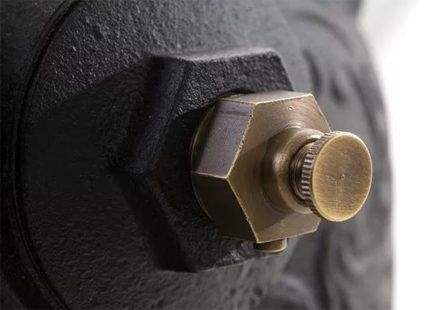
The hole is drilled with a metal drill using a drill, and the thread is cut with a tap. Of course, the diameter of the drill is chosen 1 - 1.5 mm less than the installation size of the faucet, and the tap is exactly the size.
Features of inclusion in the heating system
There are some peculiarities in the installation of air vent valves when they are screwed into the body of existing radiator plugs. Radiator plugs are usually screwed into the left-hand thread.
The faucet twists to the right, and therefore the plumber needs to fix the plug with one key and at the same time tighten the air vent with the second. But these are technical details that it wouldn’t hurt for inexperienced people to know about.
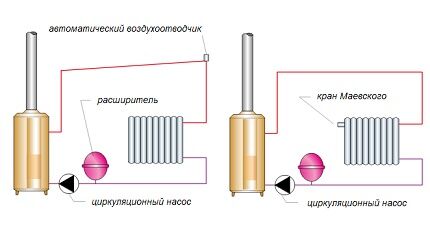
The installation diagram for air exhaust devices also has some features. So, if the radiator system is built according to a vertical arrangement of devices, air vent valves are usually placed on heating radiators the highest level.
But in a parallel connection scheme, even with a vertical structure, Mayevsky taps are installed in heating devices of the lower and upper levels. In general, in plumbing practice, installation in each individual case is done taking into account the possible accumulation of air in the system.

If carried out heating system installation according to the horizontal scheme, here, as a rule, each heating device is equipped with air vents. By and large, it is advisable to equip almost any heating system equipment with air vent valves.
In reality the following equipment should be equipped:
- all heating batteries in the system;
- compensators, bypasses and similar devices;
- recorders and coils;
- pipelines of the upper level of the heating system.
Some circuit solutions even provide for the placement of a Mayevsky tap on heated towel rails. By the way, there are models of heated towel rails on sale whose designs have an entry point for the Mayevsky tap.
Advice for the benefit of the business
Before deciding to purchase air exhaust devices, it is recommended to carefully study instrument layout diagram in the heating circuit.

Depending on the degree of freedom of access to the equipment, Mayevsky cranes of a suitable modification should be installed.
Where it is difficult to work with a screwdriver, turnkey models are better suited, and where it is difficult to work with keys, it is wise to place automatic devices. Careful analysis will help make device maintenance more efficient and save on purchases.
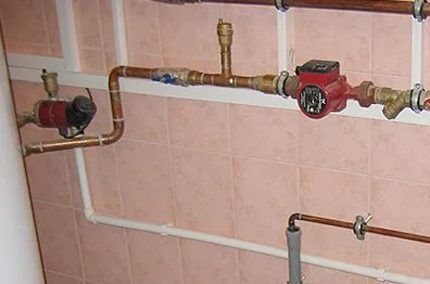
Manual devices have the most simplified design, for example, compared to automatic air vents.But, as practice shows, simplicity is the key to reliability.
If the heating system uses cast iron radiators, manual taps seem more reliable for such a system than automatic ones. Meanwhile, the degree of reliability of the design largely depends on the quality of the metal (brass) from which the air vent is made.
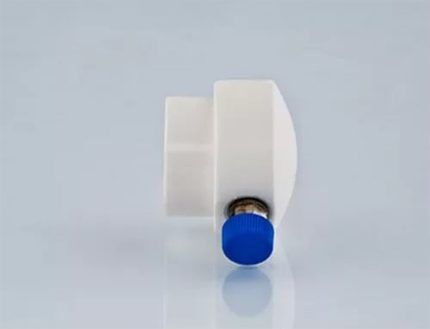
You can also mention the experience of introducing Mayevsky taps into heating circuits built on plastic pipes. This material quite reliably maintains stable pressure and temperature, but is weak against water hammer.
Installation of a Mayevsky tap paired with a safety valve or a complete security team increases system reliability for such cases. In general, for circuits where pressure stability is in question, it is recommended to use taps as stabilizers.
Conclusions and useful video on the topic
The video demonstrates the principle of operation of the Mayevsky crane and provides recommendations for its installation:
Simple in design and easy to maintain, air vents are also an integral technical part of any heating system. Deliberate exclusion of devices from the system threatens to result in serious consequences, including defrosting of batteries and pipes in winter. It is impossible to ignore Mayevsky’s taps; they just need to be selected for a specific system.
Please write comments in the block below. Tell us about your own experience in installing mechanical air vents. Ask questions, share your opinion and photographs on the topic.




I live on the fifth floor, so almost every day I have to bleed the air that forms in the system. I installed the Mayevsky faucet of the old design, that is, I bleed the air using a flat-head screwdriver. This is not very convenient. Based on the information, it is not recommended to install automatic taps on cast iron radiators, it’s a pity, or the heating system needs to be completely changed.
I didn’t even have a faucet, but a screw screwed into the radiator, which was supposed to be screwed together with a removable piece of iron. Then it got stuck to the pipe and had to be replaced. The plumber told me which one to buy, in general, the principle is the same, only there is a valve that you turn with your hand, and not with a piece of iron. If I had known there were automatic options, I would have bought them better.
On a cast iron battery, only two sections are warm, supply and return, everything else is cold. Neither water nor air is released. Is there a problem with the Mayevsky crane or with the battery itself?